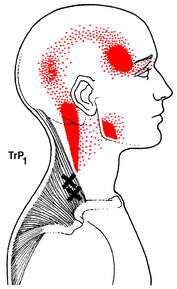 Trigger points (MTrP) are discrete, focal, hyperirritable spots located in a taut band of skeletal muscle. They produce pain locally and in a referred pattern which often accompany chronic musculoskeletal disorders. Acute trauma or repetitive movements may lead to the development of stress on muscle fibers and the formation of trigger points. Patients may have regional, persistent pain resulting in a decreased range of motion in the affected muscles. These include muscles used to maintain body posture, such as those in the neck, shoulders, and pelvic girdle. Trigger points may also manifest as tension headache, tinnitus, temporomandibular joint pain, decreased range of motion in the legs, and low back pain.  Unfortunately, much of the terminology, theories, concepts, and diagnostic criteria are inconsistent, incomplete, or controversial. U.S. physician Janet Travell, and her partner Rinzler, coined the term “myofascial trigger point” in the 1950s, reflecting their finding that the nodules can be present and refer pain (pain experienced away from the location of the trigger point) to both muscle and overlying fascia. Although the MTrP is a common physical finding, it is often an overlooked component of non-articular musculoskeletal pain because its pathophysiology is not fully understood. In spite of its high prevalence in patients, it is not a commonly established diagnosis, and is considered to be the great imitator.  Research suggests strong evidence supporting chiropractic manipulation, ischemic pressure, and electric stimulation for immediate pain relief at MTrPs. A successful treatment protocol relies on identifying trigger points and elongating the structures affected along their natural range of motion and length by stretching the muscle in conjunction with passive, active, active isolated (AIS), muscle energy techniques (MET), and proprioceptive neuromuscular facilitation (PNF) stretching to be effective. If you, or a loved one, suffers from pain, call our office today at (203) 842-8631 For further questions, e-mail [email protected] Information provided by PubMed®
A service of the National Library of Medicine, PubMed® contains publication information and (in most cases) brief summaries of articles from scientific and medical journals. For guidance from NCCIH on using PubMed, see How To Find Information About Complementary Health Approaches on PubMed. Website: www.ncbi.nlm.nih.gov/pubmed Shah JP, Thaker N, Heimur J, Aredo JV, Sikdar S, Gerber L. Myofascial Trigger Points Then and Now: A Historical and Scientific Perspective. PM R. 2015;7(7):746–761. doi:10.1016/j.pmrj.2015.01.024 J Manipulative Physiol Ther. 2009 Jan;32(1):14-24. doi: 10.1016/j.jmpt.2008.06.012. Chiropractic management of myofascial trigger points and myofascial pain syndrome: a systematic review of the literature. Vernon H1, Schneider M.
1 Comment
6/27/2023 05:30:27 pm
This article offers a brief but informative overview of trigger points, their symptoms, and potential treatment approaches. It can be a helpful resource for individuals seeking a basic understanding of trigger points and their management.
Reply
Leave a Reply. |
AuthorThe Shelton Sports & Spine Blog is for answering your questions! Stay tuned to learn about our practice, health, food, treatments, and more! Archives
July 2024
Categories |
|
|
4 Armstrong Road
Suite T120 Shelton, CT 06484 (203) 842-8631 |

 RSS Feed
RSS Feed